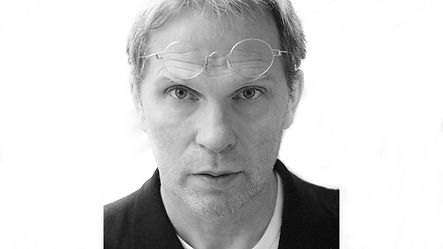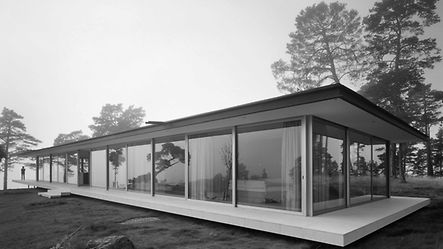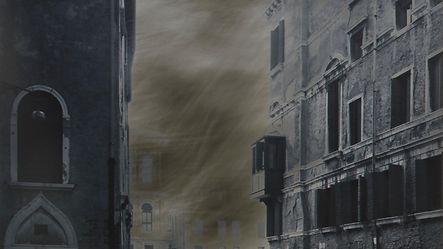Discovering the magic of a place
E:son Lindman cannot and will not simply make reproductions. The type of view he has of an architectural building reveals a lot about feelings and imagination, subjectivity and connotations. E:son simply cannot do it any other way and therefore his photographs are always very special. A touch of magic. You doubt reality. Is it a rendering? Is that mist really there? That light? A mood that appears to be reflected in the architecture?

The Reflection of Character ans Depth through Form and Space
Using angles, light and shadow, he seeks to highlight the three-dimensionality of his buildings. He sees the architecture and not just the image. "I try to understand and reproduce the principles of a building, the aspects of form and space and the intentions of the architect." Lindman creates a special connection to the building in front of him. He seems to instinctively know how a photograph needs to be composed in order to reflect the character and depth of the architecture. He conveys breathtaking details as well as the history of a place. It is a feeling that resonates in his photographs. History plays an elementary role for him – not just the history of the building itself, but of photography as a medium. "I am inspired by the curiosity and inquisitiveness of pioneering photographers, the processes of analogue photography, its chemistry and its specific materiality." This is reflected in the tactile quality of his images. Digitalisation has not diminished his fascination. On the contrary: he values analogue technology for its deliberate slowness, its thoughtfulness and its inherent, specific character. For example, Lindman always tries to compose the image with his camera rather than cropping and scaling it in the studio.
Nature can be both a Canvas and a Colour.
The surrounding nature is key for him and his images. It is almost always an ally and seldom an opponent; it is both a spectacle and the background. "Nature for me is a positive force which inspires me and enriches my work." Lindman welcomes its influence and remains patient. "I don't mind waiting a while for the right sky and the perfect alignment of the clouds." He also does not alter the scene with artificial lighting and additional spotlights, as he believes that natural lighting is an inherent part of the building and its interior. His photographs rarely contain people, partly because of the long exposure times, and partly because people age much faster than the spaces he captures. "Architecture is timeless, even though it is defined by its time period with certain things like the selection of materials and designs." If a person can be seen in his images, then they have a specific role in capturing the moment and reproducing the atmosphere. They remain blurred, however, like a blink of an eye, so that they don't interfere with the timelessness of the photograph.


From Embassy and Palace to Tree Hotel and Summer House
Italy, Belgium, Greece Beijing, Barcelona, New York City. The list of countries and cities Lindman has visited is long. The spectrum of his photographs of architecture and nature is just as extensive and ranges from ancient ruins to grass formations and new buildings. A magical view of the water in Venice, through the edges of palazzos, grass which becomes a composition that only nature can produce. Dealing with uncertainties like the weather plays an important role in the creation of his images. However, the unpredictable is also elementary for his artworks. One of Lindman's passions is creating chemigrams. These experimental works are essentially photographs taken without a camera. They do not show any objects or people, but contours, forms and atmospheres emerge through traces of developer and fixer, transforming the images almost into landscapes.
Experimenting with the unpredictable Requires an open mind and quick Thinking.
He is fascinated by the uncontrolled process of chemigram development and working in the moment. Just like the pioneers of photography, who appreciated mistakes and their intrinsic transformative power. Their experiments, which were often accidental, have a defined aesthetic quality which was beneficial for both art and image. Åke E:son Lindman works with the same mindset. The chemigrams are characterised by a mixture of subtle colours. Warm brown tones meet sand and stone, but also shimmer with a hint of metallic and fir green. The contrast between light and dark is always in the foreground. He creates an area of tension in the otherwise peaceful images and arouses the curiosity of the viewer. In the darkroom, Lindman tries to trap the unstable nature and capture it in his images. He improvises, follows the constantly changing process and intervenes wherever possible – and desirable. “The development is fascinating because every second makes a difference and the result is never the same. Chemigrams are the perfect counterbalance to my architectural works, for the unpredictability forms a unique contrast to the pursuit of perfection in architectural photography.


Outside of Time and Space yet at precisely the right Moment
His chemigrams point to a time before or after civilisation. The absence of people and focused details reflects a feeling of detachment. They convey the essence of a view and are characterised by apparent fog, light and shade, which gives them a direct connection to his architectural works.